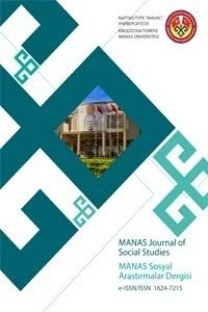ULUSLARARASI ÖĞRENCİLER, ULUS MARKALAMA VE İYİ ÜLKE İNDEKSİ: TÜRKİYE ÖRNEĞİ
INTERNATIONAL STUDENTS, NATION BRANDING AND THE GOOD COUNTRY INDEX: TURKEY EXAMPLE
___
- ‘Project Atlas’ (and global mobility trends): (access), https://www.iie.org/Research-and-Insights/ProjectAtlas/Explore-Data/Current-Infographics, 10.06.2018.
- About Good Country Index: https://goodcountry.org/good-country/data-treatment, (access) 20.03.2018.
- Akıllı, E. (2016), Türkiye’de Devlet Kimliği ve Dış Politika, Ankara: Nobel Yayınevi, 2nd Edition.
- Anholt, S. (2007a). Competitive Identity. London: Palgrave Macmillan
- Anholt, S. “The Good Country Index, a New Way of Looking at the World”, (access), https://goodcountry.org/index/about-the-index, 20.03.2018.
- Anholt, S. “What is a nation brand?”, (access), http://www.superbrands.com/turkeysb/trcopy/files/Anholt_3939.pdf, 20.03.2018.
- Anholt, S. “Why the Good Country Index?”, (access), https://goodcountry.org/index/your-questions/background, 20.03.2018.
- Badhwar, M. (2013), “Impact of Foreign Education System in India”, International Journal of Computing and Corporate Research, 3 (4), 1-13.
- Fan, Y. (2006). “Branding the Nation: What Is Being Branded?” Journal of Vacation Marketing, 12(1), 5-14.
- General Explanation about the Good Country Index Data: (access), https://goodcountry.org/index/source-data, 20.03.2018.
- Jaffe E.D. and Nebenzahl, I.D. (2006) National Image & Competitive Advantage the Theory and Practice of Place Branding, Copenhagen Business School Press.
- Kapferer, J.N (1997). Strategic Brand Management: Creating and Sustaining Brand Equity Long Term, London: Auflage.
- Kesten, A., Kıroğlu, K. and Elma, C. (2010), “Language and Education Problems of International Students in Turkey”, Manas Journal of Social Studies, 12(24), 65-85.
- Kotler, P. and Gertner, D. (2002), “Country as brand, product, and beyond: A place marketing and brand management perspective.” Journal of brand management, 9(4), 249-261.
- Lee, G. (2009), “A Theory of Soft Power and Korea's Soft Power Strategy,”, Korean Journal of Defense Analysis, 21(2), (Access), http://www.tandfonline.com/doi/pdf/10.1080/10163270902913962, 212-213.
- Lee, K. M. (2009) Nation branding and sustainable competitiveness of nations. University of Twente.
- Martinez de Morentin J. I., (2004), What is International Education? UNESCO Answers, San Sebastian: UNESCO Centre.
- NAFSA DATA, “New NAFSA Data: International Students Contribute $32.8 Billion to the U.S. Economy”, NAFSA, (access), https://www.nafsa.org/About_Us/About_NAFSA/Press/New_NAFSA_Data__International_Students_C ontribute_$32_8_Billion_to_the_U_S__Economy/, 10.06.2018. Nye, J. (1990), Bound to Lead: The Changing Nature of American Power, New York: Basic Books.
- Nye, J. (2005), Yumuşak Güç: Dünya Siyasetinde Başarının Yolu, (Translator) Rayhan İnan Aydın, Ankara: Elips Kitap.
- Oğuzlu, T. (2007) “Soft Power in Turkish Foreign Policy”, Australian Journal of International Affairs, 61(1), 81-97.
- Özoğlu, M., Gür, B., and Coşkun, İ. (2012). Küresel Eğilimler Işığında Türkiye’de Uluslararası Öğrenciler, Ankara: Seta.
- Purtaş, F. (2013). Türk Dış Politikasının Yükselen Değeri: Kültürel Diplomasi, Akademik Bakış Dergisi, 7(13), 1-14.
- Szondi, G. (2007). The role and challenges of country branding in transition countries: The Central and Eastern European experience. Place Branding and Public Diplomacy, 3(1), 8-20
- Turkey’s results on “Good Country Index 2017”, (access), https://goodcountry.org/index/results#TUR, 20.03.2018.
- Turkish Language Society, “Güç”, (access), http://www.tdk.gov.tr/index.php?option=com_gts&arama=gts&guid=TDK.GTS.5137e60e290a57.3749 3234, 07.03.2018.
- Yükseköğrenim Kurulu (YÖK), Mevlana Değişim Programı, (access), http://www.yok.gov.tr/documents/757816/1684767/mevlana_kitapcik.pdf/410e03de-63e8-42e8-9684- ad0abb35fcb3, 29.05.2018
- Yurtdışı Türkler Başkanlığı, “Turkey Scholarships”, please visit: (access), https://www.turkiyeburslari.gov.tr/, 10.06.2018.
- ISSN: 1694-7215
- Yayın Aralığı: 4
- Başlangıç: 2001
- Yayıncı: KIRGIZİSTAN-TÜRKİYE MANAS ÜNİVERSİTESİ
TAŞKÖPRÜLÜ-ZÂDE’YE GÖRE ÖĞRETMENLİK VE ÖĞRENCİLİK AHLAKI
MÜŞTERİ SADAKATİ OLUŞTURMADA ALGILANAN DEĞERİN ETKİSİ: BİR CAĞ KEBAP RESTORANI ÖRNEĞİ
İSLAM HUKUKUNDA ŞÂYİ MALIN KİRALANMASI
ESRA GÜLENGÜL, Mâzin Misbah SABBÂH
TEDARİKÇİ İLİŞKİLERİNİN İNOVASYONA ETKİSİ: GAZİANTEP ORGANİZE SANAYİ BÖLGESİ’NDE BİR ARAŞTIRMA
BAZI AVRUPALI RESSAMLARIN “KANA’DA DÜĞÜN” KONULU ESERLERİ ÜZERİNE
